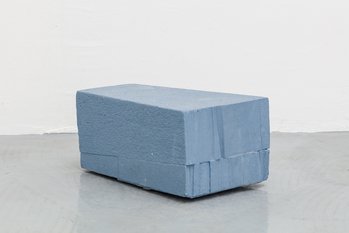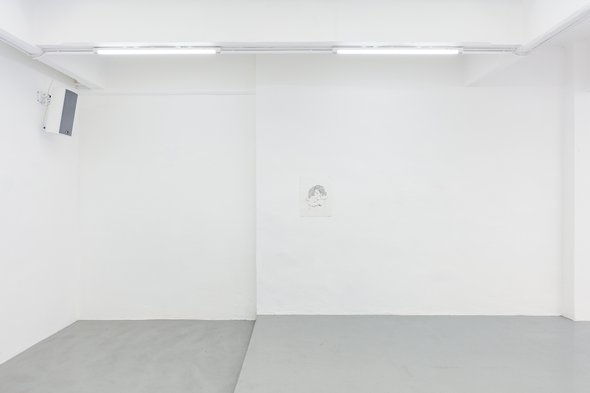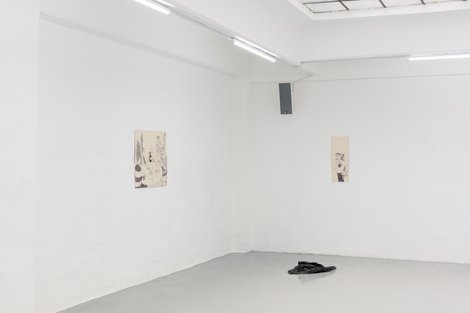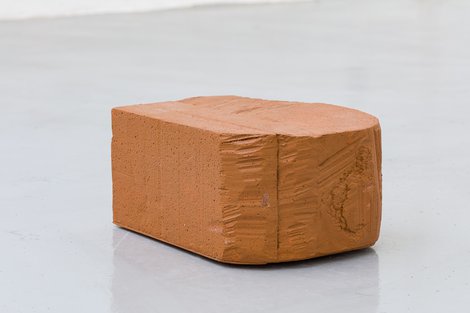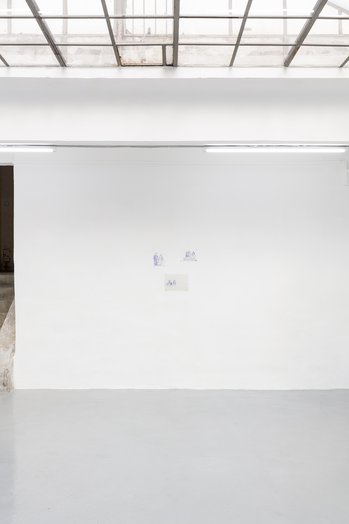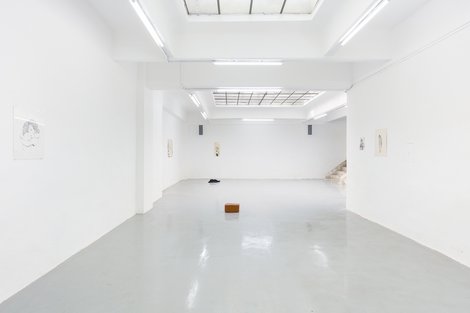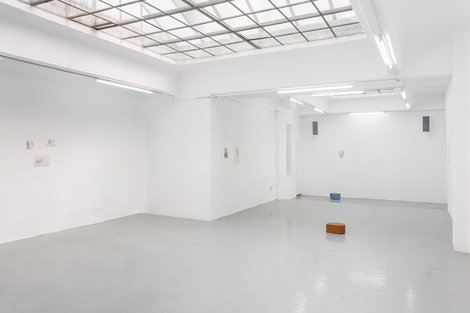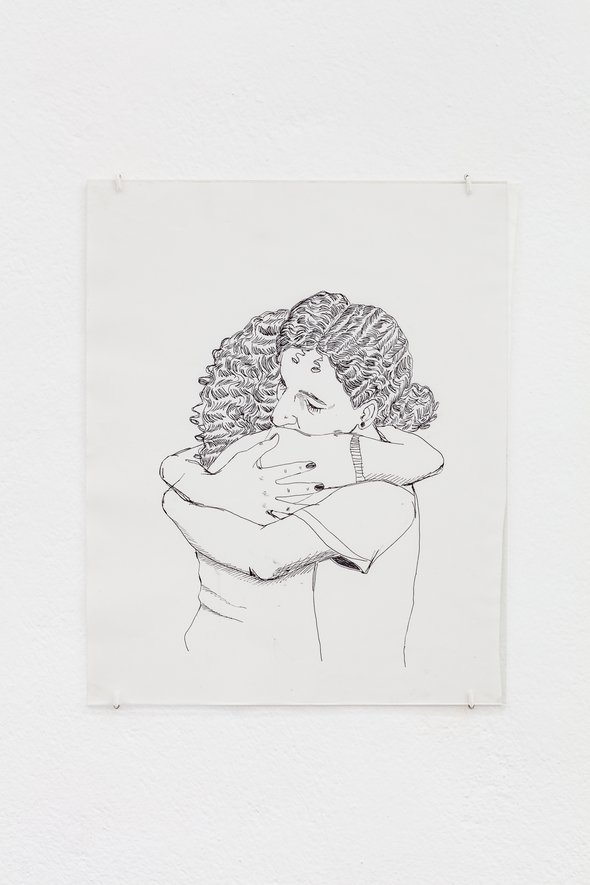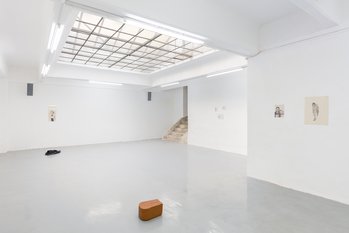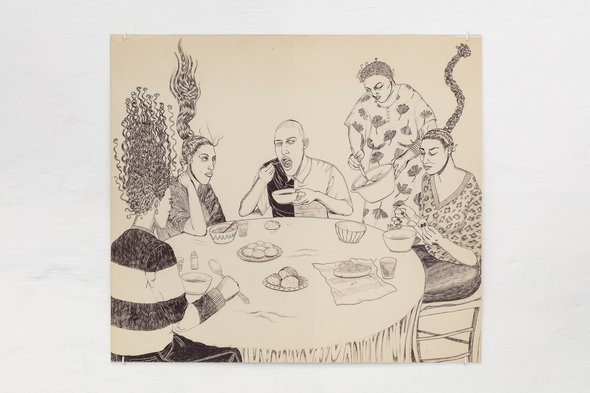Tricksters
Robert Breer, Neïla Czermak Ichti, Rhea Fowler, Micaela Tobin
Robert Breer, Neïla Czermak Ichti, Rhea Fowler, Micaela Tobin
What is under the carpet is not visible. When something is swept under the carpet it may not attract attention and is not mutable. Pulling the rug out from someone’s feet, metaphorically unsettling someone’s belief and material existence, is a classical slapstick trick. How many hours have you spent watching or playing cartoon characters getting their heads flattened by frying pans and bodies smashed into accordions? Slapstick slyness is the trickster’s weapon of choice, neither villain nor hero but both, one and the other. Removing the rug might open a trap door into the grainy duplicity of what we call common reality.
Robert Breer’s rug sculpture hovers through the gallery. The ‘Floats’ are like nodes that mark the convergence of multiple trains of thought. Made of painted styrofoam, neutral in color and shape, the motorized objects move slowly, animated like buoys in the sea. With great tranquility, they seem to follow random paths, introducing a kinetic energy that proliferates the possible points of view of the very moment. And then, they casually drift out of the picture.
Glacial Hymn, composed by Micaela Tobin and Rhea Fowler (Los Angeles, CA), is inspired by the slow movement of Rober Breer’s ‘Floats,’ in tandem with his often humorous recollections of attending church as a child. The piece is written for quadraphonic sound, creating a different auditory experience for the listener, depending on where they are within the space. Listeners are encouraged to consider the soft and subtle hums of the motorised sculptures as part of the music.
Robert Breer’s rug sculpture hovers through the gallery. The ‘Floats’ are like nodes that mark the convergence of multiple trains of thought. Made of painted styrofoam, neutral in color and shape, the motorized objects move slowly, animated like buoys in the sea. With great tranquility, they seem to follow random paths, introducing a kinetic energy that proliferates the possible points of view of the very moment. And then, they casually drift out of the picture.
Glacial Hymn, composed by Micaela Tobin and Rhea Fowler (Los Angeles, CA), is inspired by the slow movement of Rober Breer’s ‘Floats,’ in tandem with his often humorous recollections of attending church as a child. The piece is written for quadraphonic sound, creating a different auditory experience for the listener, depending on where they are within the space. Listeners are encouraged to consider the soft and subtle hums of the motorised sculptures as part of the music.

4.09.21—23.10.21
GIANNI MANHATTAN, Wassergasse 14, 1030 Vienna
> Installation views
What is under the carpet is not visible. When something is swept under the carpet it may not attract attention and is not mutable. Pulling the rug out from someone’s feet, metaphorically unsettling someone’s belief and material existence, is a classical slapstick trick. How many hours have you spent watching or playing cartoon characters getting their heads flattened by frying pans and bodies smashed into accordions? Slapstick slyness is the trickster’s weapon of choice, neither villain nor hero but both, one and the other. Removing the rug might open a trap door into the grainy duplicity of what we call common reality.
Robert Breer’s rug sculpture hovers through the gallery. The ‘Floats’ are like nodes that mark the convergence of multiple trains of thought. Made of painted styrofoam, neutral in color and shape, the motorized objects move slowly, animated like buoys in the sea. With great tranquility, they seem to follow random paths, introducing a kinetic energy that proliferates the possible points of view of the very moment. And then, they casually drift out of the picture.
Glacial Hymn, composed by Micaela Tobin and Rhea Fowler (Los Angeles, CA), is inspired by the slow movement of Rober Breer’s ‘Floats,’ in tandem with his often humorous recollections of attending church as a child. The piece is written for quadraphonic sound, creating a different auditory experience for the listener, depending on where they are within the space. Listeners are encouraged to consider the soft and subtle hums of the motorised sculptures as part of the music.
Robert Breer’s rug sculpture hovers through the gallery. The ‘Floats’ are like nodes that mark the convergence of multiple trains of thought. Made of painted styrofoam, neutral in color and shape, the motorized objects move slowly, animated like buoys in the sea. With great tranquility, they seem to follow random paths, introducing a kinetic energy that proliferates the possible points of view of the very moment. And then, they casually drift out of the picture.
Glacial Hymn, composed by Micaela Tobin and Rhea Fowler (Los Angeles, CA), is inspired by the slow movement of Rober Breer’s ‘Floats,’ in tandem with his often humorous recollections of attending church as a child. The piece is written for quadraphonic sound, creating a different auditory experience for the listener, depending on where they are within the space. Listeners are encouraged to consider the soft and subtle hums of the motorised sculptures as part of the music.
Neïla Czermak Ichti’s witty observations draw latent meanings to the surface.
The precise but casual ballpoint drawings on cropped paper open up multiple frames of reference to everyday moments of life. Drawn from her personal archive—photos of her family combined with stills from early mafia films and screenshots from horror movies—Ichti’s characters transmit the tempers and tunes of the weird. Sporting Sonic, Caspar, or Alien on their T-shirts, they invite us to redefine our certainties about the unreal and remind us that meanings never stand still. They move, volatile like a voice or like the rug beneath your feet.
The gallery door is both entrance and exit. Your breath is warming my hands and cooling your soup. Tears suggest both tragedy and joy. There are always different ideas about the same thing at the same time.
The precise but casual ballpoint drawings on cropped paper open up multiple frames of reference to everyday moments of life. Drawn from her personal archive—photos of her family combined with stills from early mafia films and screenshots from horror movies—Ichti’s characters transmit the tempers and tunes of the weird. Sporting Sonic, Caspar, or Alien on their T-shirts, they invite us to redefine our certainties about the unreal and remind us that meanings never stand still. They move, volatile like a voice or like the rug beneath your feet.
The gallery door is both entrance and exit. Your breath is warming my hands and cooling your soup. Tears suggest both tragedy and joy. There are always different ideas about the same thing at the same time.

Robert Breer worked in different media including sculpture, painting, drawing and film. Born in 1926 in Detroit, Michigan, he died in Tucson, Arizona in 2011. Fascinated by the idea of animating images he transformed his paintings into flip books and later animated videos, exploring interactions between color, speed, and the appearance and disappearance of shapes. Robert Breer’s ‘Floats’ reveal an unstable present. His work puts the observer at the centre of a complex, ever-changing world.
Neïla Czermak Ichti (1996) recently graduated from Ecole des Beaux-Arts in Marseille. Through drawing and painting she tackles questions such as the representation of collective memories and emotions, as well as transmitting invisible dimensions of life, stories that are often forgotten and taken for granted. Ichti lives and works in Marseille.
Micaela Tobin is a soprano, sound artist, and teacher based in Los Angeles, who specializes in experimental voice and contemporary opera. Micaela’s recent work re-imagines the precolonial mythology of her motherland, the Philippines and challenges Euro-centric narrative through the blending of noise, drone, and opera. Micaela recently premiered an opera-film based on her critically acclaimed album (co-written with Rhea Fowler), Bakunawa: Opera of the Seven Moons through REDCAT, Los Angeles. Of the album, The New Yorker Magazine asserts that “opera would do well to pay attention.”
Rhea Fowler is a multi-instrumentalist, composer, and teacher based in Los Angeles. Rhea is passionate about bringing awareness to current political and social issues through music, and enjoys creating innovative arrangements of traditional classical pieces that often incorporate spoken word and poetry. As a violinist, Rhea is an active recording artist in the Hollywood studios with recent credits including Space Jam: A New Legacy, King Richard, and The Lion King.
Neïla Czermak Ichti (1996) recently graduated from Ecole des Beaux-Arts in Marseille. Through drawing and painting she tackles questions such as the representation of collective memories and emotions, as well as transmitting invisible dimensions of life, stories that are often forgotten and taken for granted. Ichti lives and works in Marseille.
Micaela Tobin is a soprano, sound artist, and teacher based in Los Angeles, who specializes in experimental voice and contemporary opera. Micaela’s recent work re-imagines the precolonial mythology of her motherland, the Philippines and challenges Euro-centric narrative through the blending of noise, drone, and opera. Micaela recently premiered an opera-film based on her critically acclaimed album (co-written with Rhea Fowler), Bakunawa: Opera of the Seven Moons through REDCAT, Los Angeles. Of the album, The New Yorker Magazine asserts that “opera would do well to pay attention.”
Rhea Fowler is a multi-instrumentalist, composer, and teacher based in Los Angeles. Rhea is passionate about bringing awareness to current political and social issues through music, and enjoys creating innovative arrangements of traditional classical pieces that often incorporate spoken word and poetry. As a violinist, Rhea is an active recording artist in the Hollywood studios with recent credits including Space Jam: A New Legacy, King Richard, and The Lion King.
